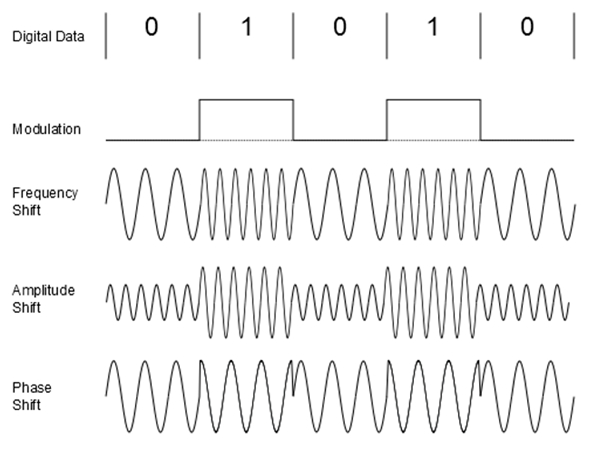
Amplitude Shift Keying (ASK), Frequency Shift Keying (FSK), and Phase Shift Keying (PSK)
In the world of digital communication, the transfer of data is a fundamental requirement for various applications. To achieve efficient data transmission over a communication channel, modulation techniques play a crucial role. Three widely used digital modulation techniques are Amplitude Shift Keying (ASK), Frequency Shift Keying (FSK), and Phase Shift Keying (PSK). In this article, we will delve into the concepts of these techniques and illustrate them with appropriate diagrams.
Amplitude Shift Keying (ASK):
Amplitude Shift Keying (ASK) is a digital modulation technique that alters the amplitude of a carrier signal to represent digital data. The basic idea behind ASK is straightforward; it modulates the carrier signal by varying its amplitude according to the digital input. The amplitude of the carrier signal is switched between two levels to represent binary data (0s and 1s).
Working Principle of ASK: When the digital input is 1, the carrier signal’s amplitude is set to a specific value (A1), and when the input is 0, the amplitude is set to a different value (A0). This variation in amplitude allows for the encoding and transmission of digital information.
Diagram:

Frequency Shift Keying (FSK):
Frequency Shift Keying (FSK) is another digital modulation technique that manipulates the frequency of the carrier signal to convey digital data. In FSK, the carrier signal switches between two predefined frequencies to represent binary information. Each frequency corresponds to one of the binary digits (0 or 1).
Working Principle of FSK: When the digital input is 1, the carrier signal’s frequency is set to f1, and when the input is 0, the frequency is set to f0. The receiver then detects these frequency variations and decodes them back to their original binary format.
Diagram:

Phase Shift Keying (PSK):
Phase Shift Keying (PSK) is a digital modulation technique that alters the phase of the carrier signal to represent digital data. In PSK, the carrier signal’s phase is shifted between predetermined angles to convey binary information.
Working Principle of PSK: When the digital input is 1, the phase of the carrier signal is shifted to a specific angle (θ1), and when the input is 0, the phase is shifted to a different angle (θ0). The receiver then detects these phase changes to recover the original binary data.
Diagram:

Conclusion
Amplitude Shift Keying (ASK), Frequency Shift Keying (FSK), and Phase Shift Keying (PSK) are essential digital modulation techniques used in various communication systems. Each technique offers its unique advantages and is suited for specific applications. ASK is simple and suitable for low-cost systems, FSK is robust in noisy environments, while PSK is efficient in high data rate applications.
Understanding these digital modulation techniques is crucial for communication engineers, as they provide the foundation for designing and implementing reliable communication systems across various industries. Whether it’s transmitting data over long distances, wireless communication, or satellite links, ASK, FSK, and PSK continue to be integral to modern digital communication.